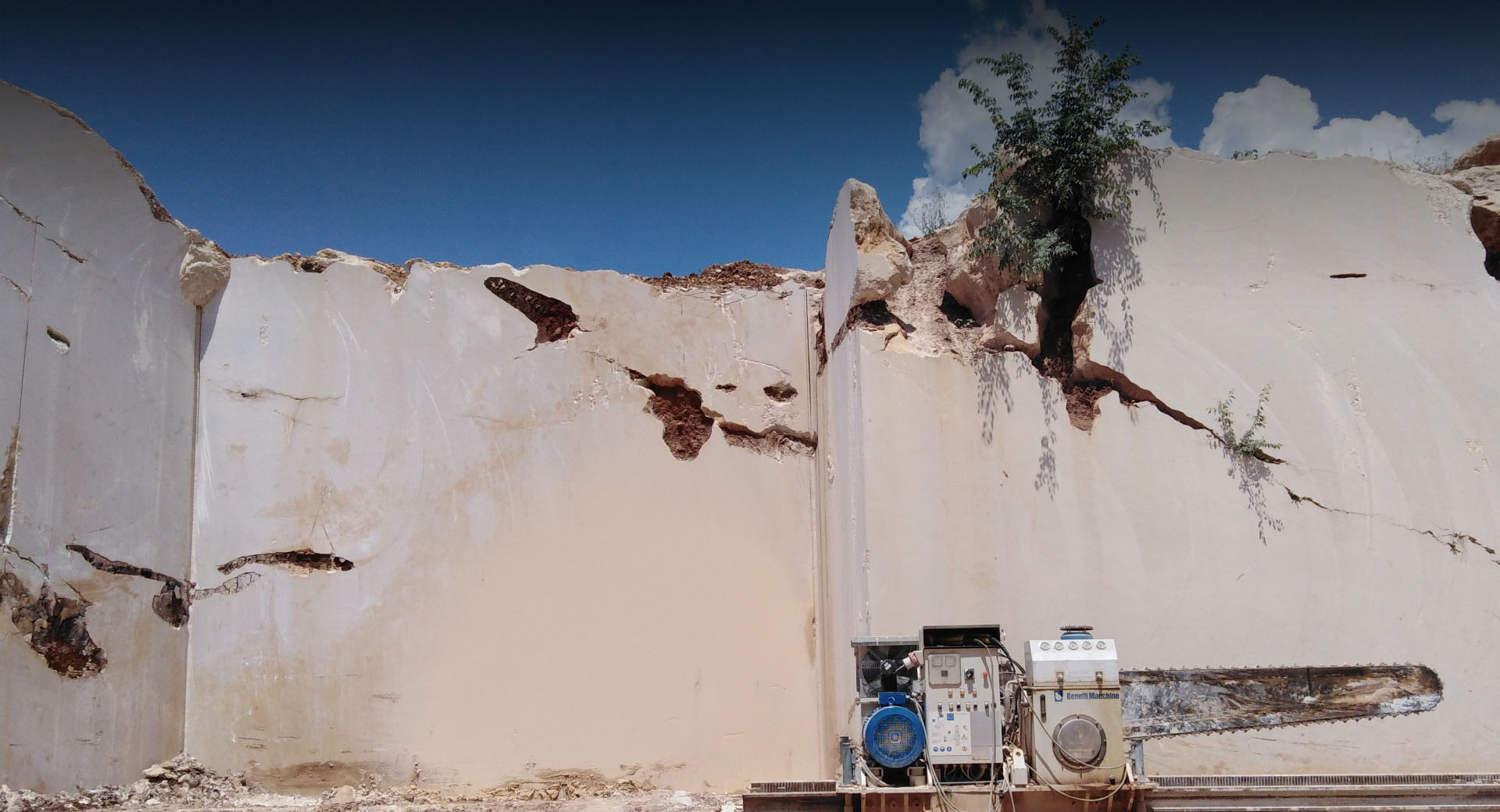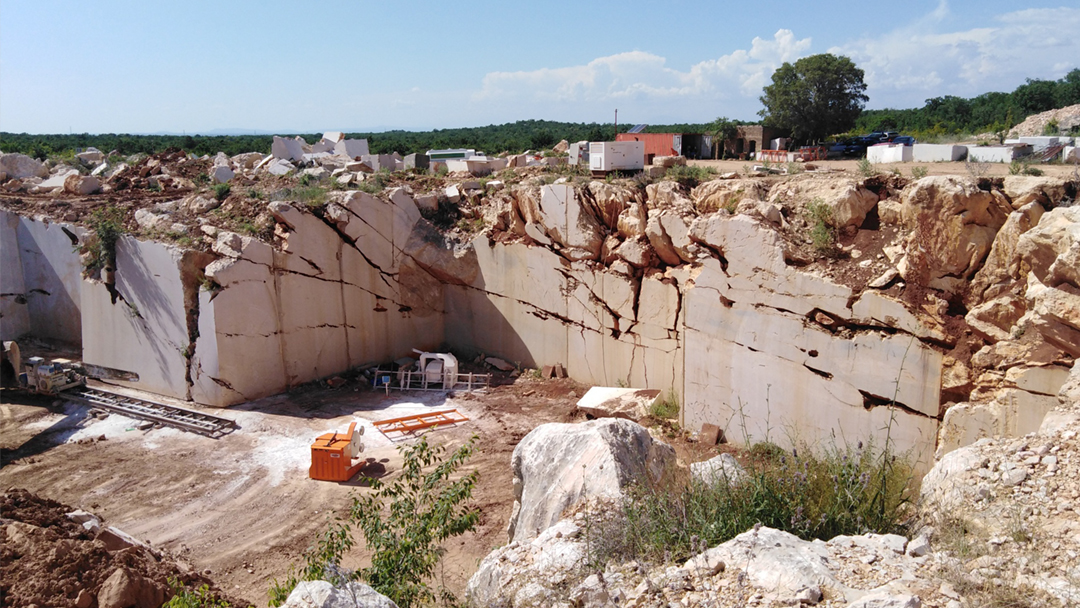-
High quality stones
The results of laboratory analysis indicate that the architectural stone from the Sedramić Quarry is of high quality and may be used for interior and exterior horizontal floor lining, for high foot-traffic areas (over 15,000 persons per day), vertical wall surfaces, etc. The stone is extremely strong, and its polishing leads to a high gloss.
-
Location
Quarry SEDRAMIĆ - 30 km away from the town of Šibenik, where there is also a port for transhipment.
-
Techical Characteristics
There are three types of stone variants in the Sedramic quarry:
- about 70% beige called Beige Dalmacija
- about 20% amber called Amber Dalmacija
- about 10% of roze called Roze Dalmacija
The total reserves of Sendramic stones are 2.200.000 m³
Physical-mechanical properties of the stone:
Compressive strength (HR B.B8.012)
a) DRY | MEAN VALUE:
- St max 140.3 MPa
- St min 107.2 MPa
- St mean 119.9 MPa
b) WATER-SATURATED | MEAN VALUE:
- St max 162.9 MPa
- St min 91.7 MPa
- St mean 106.2 MPa
c) AFTER-FREEZING | MEAN VALUE:
- St max 108.8 MPa
- St min 87.8 MPa
- St mean 96.9 MPa
Flexural strength (HRN B.B8.017)
- St max 11.6 MPa
- St min 5.1 MPa
- St mean 8.1 MPa
Resistance to wear by scraping acc. to Boehm (HRN B.B8.015): As 15.4 cm³/50cm² - loss
Velocity of longitudinal waves: (HRN B.B8.121) 5909 m/s
Water absorption (HRM B.B8.010)*: U 0.212 mass %
Apparent density (HRM B.B8.032)* rm 2.654 t/m³
Real density (HRM B.B8.032)* Rg 2.710 t/m³
Level of density (HRM B.B8.032)* rm/rg 0.979
Porosity (HRN B.B8.032)* (1-rm/rg)x100 2.070 vol.%
Resistance to freezing (HRN B.B8.001) No. of cycles:25 resistant
Resistance to Na2SO4 crystallization (HRN B.B8.002) No. of cycles: 5 | 0.090 mass % - loss
After 5 cycles of treatment, there were no changes in appearance and the mass loss was insignificant - the stone is resistant.
DOWNLOAD TEHNICAL SPECIFICATIONS
-
History
STORY OF SEDRAMIC QUARRY:
Story of Sedramic dates back from Austro-Hungarian Monarchy, which opened a quarry for its needs and built an infrastructure and railway track to the quarry itself. From that time Sedramic stone was used in construction of a recognizable buildings and architecture around the world. Some of the most recognizable buildings are court building in Sibenik, Osijek, Vienna and many more…
After the 1st World War, the quarry was shut down until 2010. when the Unesic municipality (30 km from Sibenik) issued a concession for 40 years to extend the architectural and technical heritage of Sedramic stone. Now the Sedramic quarry is managed by Eko Abs d.o.o.
STORY OF CROATIAN STONE:
The exclusiveness of Croatia’s stone dates back to ancient Roman times, when this natural bounty was used in the great architectural wonders of Rome. Moreover, Venice practically owes its existence to Croatian stone, as Dalmatian and Istrian stone was exported to Italy to build the foundations of the city in the 1400s. The stone has survived threw all of Venice’s history and has helped to preserve many of the public works of art. The Dalmatian stone is particularly water resistant, what makes it perfect for the base of the city under the water. It comes as no surprise then, that Croatian stone is one of the most durable materials due to its nonporous physical and chemical composition.
The same stone was used to pave the famous streets of Dubrovnik on the Dalmatian Coast of Croatia. Furthermore, Dalmatian stone was used to build beautiful white columns of the White House in Washington, D.C. Why did they all use particularly the Croatian stone ? Well, because, as some sources say, “Croatian stone is the fine wine of the building industry, literally the gold standard”.
Stones like these with such high compressive strength can support massive weights without fracturing or crumbling. Erosion of the stone has been very limited over time despite its constant exposure to humid, saline, and acidic climate. Croatian stone is more durable than regular stone due to its high density and very low porosity. Water is not able to penetrate into the stone to the degree it can penetrate into the regular stone. That’s why Croatian stone has played quite an important role in the world’s architectural history.

HIGH QUALITY STONES
Sedramić Quarry
Croatian stone is the fine wine of the building industry.
Allow us to introduce you a top quality quarry in Croatia – Sedramić! According to many satisfied customers, from our quarry comes the most and beautiful and the best quality stone from this part of Europe.

Querry Sedramić
Prikaži veću kartu
Contact us
We will be happy to answer any questions you may have.






